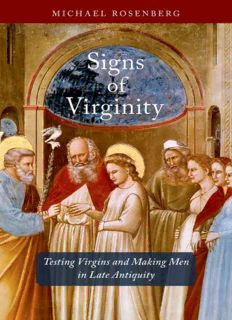
Signs of Virginity: Testing Virgins and Making Men in Late Antiquity PDF
Preview Signs of Virginity: Testing Virgins and Making Men in Late Antiquity
i Signs of Virginity ii iii Signs of Virginity Testing Virgins and Making Men in Late Antiquity z MICHAEL ROSENBERG 1 iv 1 Oxford University Press is a department of the University of Oxford. It furthers the University’s objective of excellence in research, scholarship, and education by publishing worldwide. Oxford is a registered trade mark of Oxford University Press in the UK and certain other countries. Published in the United States of America by Oxford University Press 198 Madison Avenue, New York, NY 10016, United States of America. © Oxford University Press 2018 All rights reserved. No part of this publication may be reproduced, stored in a retrieval system, or transmitted, in any form or by any means, without the prior permission in writing of Oxford University Press, or as expressly permitted by law, by license, or under terms agreed with the appropriate reproduction rights organization. Inquiries concerning reproduction outside the scope of the above should be sent to the Rights Department, Oxford University Press, at the address above. You must not circulate this work in any other form and you must impose this same condition on any acquirer. CIP data is on file at the Library of Congress ISBN 978– 0– 19– 084589– 6 1 3 5 7 9 8 6 4 2 Printed by Sheridan Books, Inc., United States of America v For my father, Joshua Baruch Rosenberg, of blessed memory. This is not the book that he wanted to write, but I think he would have understood that, at its roots, I’m struggling with the same questions. vi vii Contents Acknowledgments ix Abbreviations xiii Introduction: Defining Virginity, Making Men 1 PART I. Testing Virginity in the Body 1. Virginity and Violence in Cross- Cultural Perspective 21 2. Bloodied Sheets: The Biblical Nuptial Bed as Rape Scene 31 3. “Trustworthy Women” and Other Witnesses: Tweaking Deuteronomy in Pre- Rabbinic and Early Rabbinic Judaism 44 PART II. Testing Virginity through Faith 4. Doubts and Faith: Possible Alternatives in Three First- Century Jewish Authors 79 5. Struck by Wood, Struck by God: Virginity Beyond/ Despite Anatomy 90 viii viii Contents PART III. Subjecting Virginity 6. Open Doors and Accused Brides: Subjectivity and a New Standard for Virginity Testing in Rabbinic Babylonia 119 7. Impure Nuptials and Sex as Work: The Bavli’s Attempted Divorce of Virginity from Violence 148 8. (De)Mythologizing the Hymen: Augustine, the Bavli, and the Rejection of Force 182 Epilogue 207 Notes 215 Bibliography 289 Index 305 Index of Primary Sources 309 ix Acknowledgments If the only reward for the time I’ve spent on this book is the opportu- nity to thank some wonderful people, it will have been worth it. To begin, many institutions and teachers have been critical to my development as a reader of text and cultures—m ore than I can thank here. But particular thanks are due to my teachers at the Jewish Theological Seminary (JTS), including Eliezer Diamond, Judith Hauptman, and Neil Danzig, and espe- cially to Israel Francus, who taught me how to read for inconsistencies that can point to a world of meaning, and who demonstrated a love for Tractate Ketubot. Though my own love for this challenging and perplexing trac- tate has developed in ways that are perhaps far from Prof. Francus’s own research interests, it still takes its roots in Dr. Francus’s passion. During my time at JTS, I was fortunate to be a recipient of the Wexner Graduate Fellowship, a beneficence that not only freed me to explore widely in my learning, but also put me in contact with outstanding schol- ars and phenomenal thinkers working in a variety of fields. My debt to the Wexner Foundation and to the members of WGF Class 14 is palpable. I also benefited from a Hadassah- Brandeis Institute research award, which supported my early research on virginity testing in Rabbinic literature. My doctoral advisor at JTS, Richard Kalmin, has been an incredible resource, both patient and critical. When I decided not to turn my dis- sertation into a book, for the time being, but rather to take one tangen- tial point from it and spend years expanding it into the volume in front of you now, he supported me and offered advice and guidance that went beyond any reasonable expectation. His model of careful, critical research coupled with the very best of scholarly kindness has been and remains an inspiration to me. Many of the ideas for this book first percolated in my head when I was a rabbinical student at Yeshivat Ma’aleh Gilboa, on Kibbutz Ma’aleh Gilboa
Description: